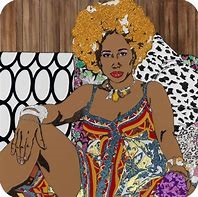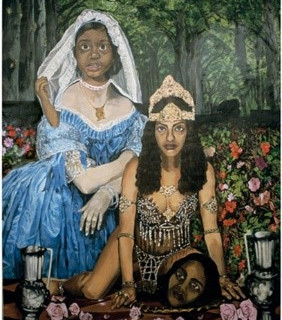After 20 years in the field working as a social worker, it has been jarring for me to reenter the university. Before this semester in this class and another called “The Hidden Curriculum of Race and Gender in the Classroom,” I had not been exposed to the academics who are upending the traditional epistemologies, frameworks, and heuristics. It has been liberating. It has liberated both my mind to be creative and my voice to be positioned, personal, and relevant to the real world. This assignment is my favorite of the last 3 years of schooling. What? I can bring my love of art into my research and framework?!! I wish I was writing this essay with a piece of charcoal, a gum eraser, and dozens of cheap newsprint! Alas, I am in the library, so no messes will occur on the desk—only in our imagination.

Our assignment from Professor Carmen Kynard: Take something that you love and know (Black Comics? Black Panther anyone?) It could be a song. It could be an artist. It could be a style or a genre (AfroPunk anyone? Unapologetically Brown series anyone?) What would that thing look like and mean as a research methodology? What difference would it make? For whom? Why? How would it challenge/change dominant culture and the academy? What would you call this new thing?
I am thinking of an art form I love-- figure drawing--as a research methodology. I have learned much about life through this practice. If I could do only one art form for the rest of my life, figure drawing also known as “life drawing” would endlessly interest me. First of all, its focus is another human and the human body. It requires time, practice, and the willingness to draw 100 bad drawings before the right one emerges. I remember reading somewhere that the human face is the first thing we learn to recognize as a baby. It is primal. I could study faces endlessly. Also, life drawing requires unlearning how you think you're supposed to draw a human body and focusing on what is actually seen and observed in reality. Authentic, non-exploitive, decolonized research should do the same.
Now, don’t think I don’t know--life drawing can be problematic. There is the “clothed” artist/viewer and the nude, often female, white, model. Taken alone this might not be a problem, but the practice exists in a long historic context of patriarchy and primacy of the white male gaze in the art world. Yet many women artists, have subverted this paradigm. First, we are not men. Second, we draw our models staring straight back at the viewer—a feminist take on the “gaze” with the “object-turned-subject” gazing back. Third, self-portrait has become a powerful art form for women, particularly women of color. Artists who come to mind as some of my favorites: Marlene Dumas, Mickalene Thomas, Wangechi Mutu, Chitra Ganesh.

What might this look like in a research framework? This seems to be one step past “participatory action research”—where community members partner with researchers to complete research together. This methodology might invite the “research subject” to look back at the researcher and observe the researcher. They could be asked what they are seeing or learning about the researcher or the research through the process of “drawing this picture.”
Other things I have learned from life drawing that I would like to flesh out in future writing:
Warming up with fast poses: you almost never go right into a life drawing session without doing 10-20 one-minute fast pose sketches as warm ups. What would it look like to practice warm ups as a research methodology?
Working on more than one drawing at a time: this has been a tool that has helped me overcome my obsessive perfectionist tendencies (I think I learned these tendencies as a white woman and its
interesting to think about undoing this in my methodology). When I am drawing, I absolutely have to have 2-3 simultaneous drawings going on at one time. This way the second I become stuck on one drawing, instead of losing my intention and making marks with no meaning when there’ no clear path, I step away from that drawing and move to another. Almost without fail, my “side drawings” and not my central drawing will be the more interesting and freely drawn images.









